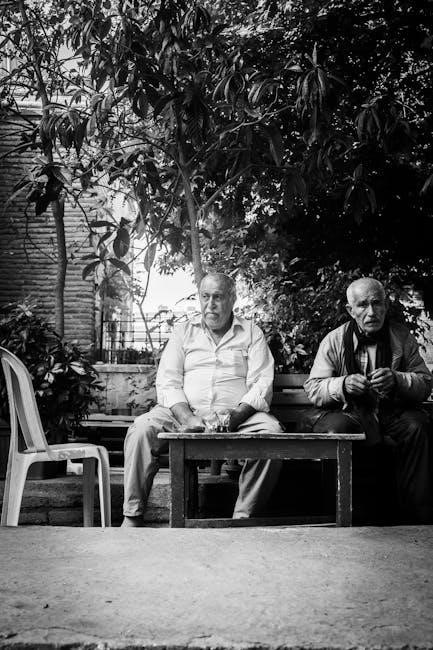The story “A Very Old Man with Enormous Wings” by Gabriel García Márquez is a timeless tale of magical realism, exploring faith, isolation, and compassion. Available as a free PDF download, it captivates readers with its mysterious narrative and profound themes, making it a popular choice for literary studies and discussions.
1.1 Background of the Story
The story revolves around the mysterious arrival of an old man with enormous wings in a small coastal village. During a heavy rainstorm, Pelayo and Elisenda discover the frail, mud-covered man in their courtyard. His divine yet human appearance sparks curiosity and fear. The villagers, believing him to be an angel, flock to see him, while the local priest questions his divinity. This enigmatic event unfolds in a setting rich with magical realism, blending the ordinary with the extraordinary, as the community grapples with faith, doubt, and compassion.
1.2 Publication and Popularity
“A Very Old Man with Enormous Wings” was first published in 1955 as part of Gabriel García Márquez’s short story collection Leaf Storm. The tale gained widespread acclaim for its unique blend of magical realism and profound themes. Its popularity soared, making it one of Márquez’s most celebrated works. The story’s enduring appeal lies in its ability to captivate both literary critics and general readers, solidifying its place in world literature. Its availability in PDF format has further expanded its reach, ensuring its timeless message continues to resonate globally.

Plot Summary
Pelayo and Elisenda discover a mysterious old man with enormous wings in their courtyard. The villagers are amazed, but the couple treats him with cautious curiosity, eventually exploiting his presence for profit until his enigmatic departure.
2.1 Discovery of the Old Man
During a rainy season, Pelayo and Elisenda find a mysterious old man with enormous wings in their courtyard. The man is frail, dirty, and appears to be fallen or lost. His massive wings, though beautiful, are deteriorated and muddy. The couple is initially startled but cautious, unsure whether he is a divine being or a trickster. Their sick child’s presence adds urgency, but the man’s arrival sparks both curiosity and fear. The discovery sets off a chain of events that transforms their quiet lives and the village’s perception of the extraordinary.
2.2 Reaction of Pelayo and Elisenda
Pelayo and Elisenda are shocked and confused by the old man’s arrival. They question whether he is an angel or a castaway but remain cautious. Elisenda worries about the implications, while Pelayo is more practical, deciding to lock him in the chicken coop. Their sick child’s condition adds to their anxiety. Despite their fear, they see the old man as a potential solution to their child’s illness. Word of the discovery spreads, drawing villagers to their home, but the couple’s initial reaction is a mix of curiosity and apprehension about the mysterious figure.
2.3 The Old Man’s Appearance and Condition
The old man with enormous wings appears frail and worn, with dirty, tattered clothing. His wings, though massive, are in poor condition—dirty and filled with parasites. He speaks in a barely intelligible dialect, adding to his mysterious presence. Despite his divine-like appearance, he is treated as a common man, reflecting both fascination and indifference. His physical state and demeanor evoke pity, yet his otherworldly features spark curiosity and fear, blending the magical with the mundane in a way that captivates all who see him.
Setting
The story unfolds in a remote seaside village, emphasizing a timeless, isolated atmosphere. The courtyard and chicken coop serve as central locations, blending the mundane with the magical, creating a unique backdrop for the extraordinary events.
3.1 Time and Place
The story is set in a remote seaside village, with the time period left unspecified, creating a timeless atmosphere. The village’s isolation emphasizes its detachment from the outside world, providing a unique backdrop for the magical events. The setting blends the ordinary with the extraordinary, as the courtyard and chicken coop become central to the narrative. This ambiguous time and place allow readers to focus on the story’s themes rather than historical context, enhancing its universal appeal and magical realism.
3.2 The Courtyard and Chicken Coop
The courtyard and chicken coop serve as central settings, transforming from ordinary spaces into sites of wonder and neglect. The chicken coop, where the old man is confined, symbolizes both captivity and the villagers’ exploitation. Over time, the courtyard’s condition mirrors the old man’s state, reflecting themes of isolation and decay. Despite the magical presence, the space remains mundane, highlighting the villagers’ indifference and the old man’s suffering. This duality underscores the story’s exploration of human nature and the intersection of the mundane with the extraordinary.

Characters
The story features the very old man with enormous wings, Pelayo, Elisenda, their child, and the priest. Each character plays a unique role in the narrative.
4.1 The Very Old Man with Enormous Wings
The old man is a mysterious, frail figure with enormous, worn wings. His weak and tired appearance contrasts with the grandeur of his wings, symbolizing both divinity and humanity. His presence sparks curiosity and fear, as villagers struggle to understand his identity. Over time, he becomes isolated, treated more as a spectacle than a being. His eventual departure reflects themes of exploitation and the fleeting nature of human compassion. His character embodies the magical realism and moral complexities of the story.
4.2 Pelayo and Elisenda
Pelayo and Elisenda are poor, working-class parents living in a remote coastal village. Their lives are marked by hardship until they discover the old man with enormous wings. Initially, they show compassion, but as time passes, they exploit his presence for financial gain. Their relationship evolves from curiosity to greed, reflecting the duality of human nature. Elisenda’s practicality contrasts with Pelayo’s hesitation, showcasing their differing perspectives on the situation. Their actions ultimately highlight themes of exploitation and moral ambiguity in the face of the unknown.
4.3 The Child
The child plays a pivotal role in the story, exhibiting a unique connection to the old man with enormous wings. Unlike the adults, the child shows curiosity and innocence, understanding the old man’s language and sensing his divine nature. This bond highlights the child’s purity and openness to the extraordinary. The child’s interactions with the old man contrast sharply with the greed and fear displayed by the adults, emphasizing themes of innocence and exploitation. The child’s presence underscores the story’s exploration of human nature and perception.
4.4 The Priest
The priest represents institutional faith, initially skeptical of the old man’s divine nature. He seeks to verify the old man’s identity, reflecting the Church’s need for tangible proof. His rigid beliefs contrast with the villagers’ superstition and the child’s innocent acceptance. The priest’s doubts highlight the tension between organized religion and personal spiritual experiences. His presence underscores the story’s exploration of faith, doubt, and the human struggle to comprehend the divine. His character serves as a bridge between the sacred and the mundane in Marquez’s magical realism.
4.5 The Villagers
The villagers embody a mix of curiosity, fear, and superstition, flocking to see the old man with enormous wings. Their reactions are driven by a desire to understand the mysterious figure, with some seeking miracles and others fearing evil. This collective behavior highlights the duality of human nature, oscillating between awe and distrust. The villagers’ actions reflect societal tendencies to sensationalize the unknown, showcasing Marquez’s critique of communal behavior and the blurred lines between faith and exploitation in the face of the extraordinary.

Themes
The story explores themes of magical realism, blending the mundane with the surreal. It delves into faith and doubt, isolation, and the tension between compassion and exploitation.
5.1 Magical Realism
The story is a quintessential example of magical realism, a genre where the extraordinary coexists with the ordinary. The arrival of an angel-like old man with enormous wings is portrayed as a mundane event, blending surrealism with everyday life. This narrative style challenges readers to accept the supernatural as normal, reflecting the human tendency to normalize the extraordinary. Marquez’s mastery of this genre creates a unique tone, balancing the bizarre with the familiar, and invites reflection on the intersection of faith, reality, and the human condition.
5.2 Faith and Doubt
The story explores the tension between faith and doubt through the villagers’ reaction to the old man. Many see him as a divine being, sparking religious devotion, while others question his nature. The Catholic Church’s skepticism, represented by the priest, contrasts with the villagers’ superstition. This duality reflects the human struggle to reconcile belief with uncertainty. The narrative highlights how faith can lead to both compassion and exploitation, as the sacred is often misunderstood or misused. This theme resonates with universal questions about spirituality and its complexities.
5.3 Isolation and Loneliness
The story emphasizes isolation and loneliness through the old man’s plight. Despite his extraordinary appearance, he is met with fear and indifference, leading to his confinement in a chicken coop. The villagers, fascinated yet wary, keep their distance, highlighting his alienation. Even Pelayo and Elisenda, though practical, show little compassion, underscoring his solitude; The narrative portrays loneliness as both a physical and emotional state, reflecting the old man’s detachment from humanity and the world’s inability to understand him. This isolation deepens the story’s poignant undertones.
5.4 Compassion and Exploitation
The story explores the duality of compassion and exploitation through the villagers’ and Pelayo’s actions. While some show curiosity or fleeting kindness, most exploit the old man for personal gain or entertainment. Pelayo and Elisenda, though practical, profit from his presence, charging visitors to see him. The villagers’ initial awe turns into indifference, reflecting how humanity often fails to balance compassion with respect. This contrast highlights the tension between empathy and self-interest, a recurring theme in Marquéz’s work, adding depth to the narrative’s moral landscape.

Symbolism
The story is rich in symbolism, blending magical elements with mundane life to explore themes of faith, isolation, and human nature, creating a profound allegorical landscape.
6.1 The Wings as a Symbol
The enormous wings symbolize the divine, transcendence, and spiritual mystery. They represent both beauty and burden, embodying the duality of human perception. The wings’ imposing presence contrasts with the old man’s frailty, highlighting the paradox of divine power and human vulnerability. They also serve as a catalyst for the villagers’ faith and doubt, sparking a mix of awe and fear. Ultimately, the wings are a metaphor for the unknown, challenging characters and readers to confront the limits of human understanding and the nature of belief.
6.2 The Rain and the Courtyard
The rain-soaked courtyard symbolizes a space of transformation and ambiguity, reflecting the story’s magical realism. It serves as the stage for the old man’s arrival, blending the mundane with the divine. The courtyard’s clutter and decay mirror the villagers’ spiritual neglect, while the rain cleansing it suggests renewal. The setting underscores themes of isolation and the intersection of the earthly and the supernatural, highlighting the tension between the ordinary and the extraordinary in the villagers’ lives and perceptions.

Title Significance
The title reflects the story’s magical realism, blending the human and divine. It highlights the old man’s burden and the villagers’ perception of his celestial presence.
7.1 The Title’s Magical Realism
The title embodies the essence of magical realism, blending the extraordinary with the ordinary. The old man’s enormous wings symbolize the supernatural, while his humanity grounds the story in reality.
This duality captivates readers, inviting them to explore the intersection of faith, doubt, and the mundane. The title’s simplicity contrasts with its profound implications, mirroring Marquez’s signature style of weaving the magical into everyday life.
It sets the tone for a narrative that challenges perceptions, leaving readers to ponder the significance of the old man’s presence and the villagers’ reactions to his otherworldly existence.
7.2 The Old Man’s Identity
The old man’s identity remains ambiguous, leaving readers to interpret his nature. While his enormous wings suggest a divine being, his frail and human-like appearance contradicts typical angelic imagery. This ambiguity is central to the story, evoking both fascination and fear among the villagers. The uncertainty surrounding his identity reflects the broader themes of faith, doubt, and the human condition. His presence challenges the villagers’ understanding of the divine, adding depth to the narrative’s magical realism.

Reception and Analysis
The story has received critical acclaim for its magical realism and profound themes, influencing cultural narratives and sparking debates on faith and humanity.
8.1 Critical Acclaim
“A Very Old Man with Enormous Wings” has garnered widespread critical acclaim for its unique blend of magical realism and profound exploration of human nature. Critics praise Márquez’s ability to weave the mundane with the extraordinary, creating a narrative that challenges traditional storytelling. The story’s themes of faith, doubt, and isolation resonate deeply, sparking intellectual and emotional debates. Its concise yet impactful prose has solidified its place as a landmark of 20th-century literature, celebrated for its psychological depth and timeless relevance.
8.2 Cultural Impact
“A Very Old Man with Enormous Wings” has left a lasting imprint on global culture, inspiring countless adaptations, artworks, and scholarly discussions. Its exploration of faith, humanity, and the surreal has resonated across cultures, making it a cornerstone of magical realism. The story has been translated into numerous languages, reaching a diverse audience and influencing writers, filmmakers, and artists worldwide. Its themes of compassion and exploitation continue to provoke reflection, cementing its role as a cultural and literary phenomenon that transcends time and borders.

Availability as a PDF
The story is widely available as a PDF online, with both free and paid versions accessible through platforms like Amazon, Google Books, and educational websites. Users can easily download or read it on various devices, making it convenient for students and enthusiasts to explore this timeless tale in a digital format.
9.1 Free Download Options
Several websites offer free PDF downloads of A Very Old Man with Enormous Wings. Platforms like PDFDrive, Scribd, and educational repositories provide accessible versions. Many universities and online libraries share the story as part of literary resources. Some sites may require sign-up or subscription for access. However, be cautious of copyright infringement and ensure downloads are from reputable sources. Additionally, some free versions may be scans of older editions, which could affect readability. Always verify the source to avoid unauthorized or low-quality downloads.
9.2 Paid Versions and Editions
The story is available in various paid formats, including hardcover, paperback, and e-book editions. These can be purchased from major online retailers like Amazon, Barnes & Noble, and Google Books. Special editions may include introductions by literary critics or forewords by renowned authors, enhancing the reader’s understanding. Purchasing a paid version supports the author and publisher while offering a high-quality reading experience. Some editions also feature exclusive content, such as analysis or study guides, making them valuable for academic purposes.

Study Guides and Resources
Study guides and resources for A Very Old Man with Enormous Wings PDF include summaries, character analyses, and discussion questions.
- Educational materials provide insights into themes like magical realism and faith.
- Lesson plans and quizzes enhance understanding for students.
- Resources are available on university websites and online educational platforms.
These tools aid deeper analysis and comprehension of the story.
10;1 Educational Materials
Educational materials for A Very Old Man with Enormous Wings are widely available, offering deep insights into the story’s themes and symbolism. Study guides provide summaries, character analyses, and discussion prompts, helping students engage with Marquez’s magical realism; Worksheets and activity plans are designed for classroom use, focusing on themes like faith and isolation. These resources are ideal for teachers and students, facilitating a comprehensive understanding of the narrative. They are accessible online, often as downloadable PDFs, making them convenient for educational purposes.
10.2 Discussion Questions
What symbolic meaning do the old man’s wings hold, and how does this relate to themes of faith and doubt? How do Pelayo and Elisenda’s actions reflect human compassion versus exploitation? What role does isolation play in shaping the old man’s existence? How does the child’s reaction to the old man differ from the villagers’, and why? What message do you think Marquez conveys through the priest’s skepticism? How does the story challenge or reinforce your beliefs about the supernatural? What lessons can be learned from the villagers’ treatment of the old man? How does the PDF format enhance your understanding or study of the story?

Adaptations and Interpretations
The story has been adapted into films, plays, and artwork, exploring its magical realism. A 1988 film and a stage play reinterpret the tale, while artists visually depict the old man’s wings and the courtyard, sparking deeper reflections on its themes.
11.1 Film and Theater Adaptations
The story has inspired various film and theater adaptations, capturing its magical realism. A notable adaptation is the 1988 Colombian film Un Señor Muy Viejo con Alas Enormes, directed by Fernando Luján, which brings the tale to life with striking visuals. Theater productions, such as the Royal Shakespeare Company’s stage version, emphasize the emotional and surreal elements. These adaptations highlight the story’s universal appeal, blending the mystical with human emotions, and have made it accessible to global audiences in different art forms.
11.2 Artistic Representations
The story has inspired various artistic interpretations, with illustrators and visual artists captivated by its magical realism. Paintings often depict the old man with wings in a surreal, dreamlike setting, emphasizing his isolation and mystical presence. Sculptures and digital art also explore the contrast between his divine appearance and the mundane courtyard. Many artists focus on the symbolic wings, using them to convey themes of faith, transformation, and the human condition. These creative works complement the narrative, inviting deeper reflection on its themes.
The story’s enduring appeal lies in its magical realism and emotional depth, offering readers a poignant reflection on faith, isolation, and humanity, while the PDF version ensures easy access for modern readers;
12.1 The Story’s Lasting Significance
The story of A Very Old Man with Enormous Wings remains a timeless masterpiece of magical realism, captivating readers with its unique blend of reality and fantasy. Its exploration of faith, humanity, and the supernatural continues to resonate deeply, making it a cornerstone of modern literature. The old man’s enigmatic presence challenges societal norms and invites reflection on compassion and exploitation. This tale, available as a PDF, has left an indelible mark on cultural and literary landscapes, ensuring its relevance for generations to come.
12.2 Final Thoughts on the PDF Version
The PDF version of “A Very Old Man with Enormous Wings” offers a convenient and accessible way to experience Marquez’s timeless tale. It preserves the story’s original charm while providing a modern format for readers. The digital version is widely available, catering to both casual readers and scholars. Whether downloaded for free or purchased, the PDF ensures that the story’s magical realism and profound themes reach a global audience. It remains a valuable resource for exploring the narrative’s depth and complexity.


